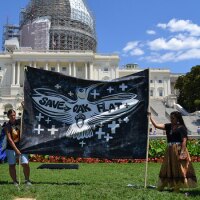Here's Why Comparing the Malheur Occupation to Standing Rock Doesn't Work


It was a bit of poetic irony that hundreds of activists at the Standing Rock reservation encampment were arrested at the same time a jury 1,200 miles away found the armed occupiers of the Malheur National Wildlife Refuge “not guilty.” The contrast between the two events was a tailor-made illustration of that phenomenon increasingly referred to as “white privilege.”
On the one hand, a group of white people avowedly pursue armed insurrection and flagrantly violate any number of laws, are allowed to cool off for weeks, then eventually walk free. On the other, Native people attempting non-violent civil disobedience are immediately met with attack dogs and pepper spray, then rubber bullets, then real bullets, then mass arrests at a peaceful encampment performed by police from several states.
The comparison is indeed illuminating, and the fact that both watershed events happened on the same day made it nearly irresistible to observers. But the comparison obscures something equally important. Using Standing Rock as an analogy for the occupation of the Malheur National Wildlife Refuge naturally leads to discussing the Malheur occupiers as roughly equivalent to the Water Protectors in South Dakota. The thing is, if you’re using Standing Rock as a metaphor to examine the Malheur occupation, the occupiers actually bear greater similarity to a different entity at Standing Rock.
Put bluntly: at Malheur, the Bundys and their cohort didn’t play the role of the Native activists. They played the role of the pipeline.
Some of the culpability for Thursday’s verdict in Portland surely lies with the Justice Department, which chose to bring Ammon and Ryan Bundy and their five codefendants up on charges of conspiracy to obstruct federal employees from carrying out their duties through intimidation, threat, or force.
The Bundy bunch incontrovertibly did obstruct federal workers from working, and an armed occupation of a federal facility is pretty much the textbook definition of intimidation, threat, and force all rolled up into one big ball. But the Justice Department failed to persuade the jury that the Bundys and their compatriots deliberately and methodically planned to idle Refuge staff, at least to the demanding standards required for a conviction on a Federal conspiracy charge.

Though the Justice Department obviously has access to more detailed data on the effects of the occupation than the public does, it would seem at first glance that there would have been several other charges that might have brought about an easier conviction. (Jurors deadlocked over a theft of government property charges brought against some of the occupiers, an indication that at least some on the jury felt the occupiers were culpable of something.)
For instance, former federal public defender Steve Wax told The Oregonian’s Maxine Bernstein,a charge of seditious conspiracy would likely have been an easier conviction. Prosecutors would only have needed to prove a conspiracy “by force to seize, take or possess any property of the United States." That would seem pretty much a slam dunk, and sentences of up to 20 years in federal prison could have resulted.
Other potential charges, however, play up the inappropriateness of comparing the Malheur occupiers to Standing Rock Water Protectors. During the 41-day occupation of the Malheur Refuge, the Bundy gang bulldozed an area known to contain numerous archaeological and historic artifacts important to the Paiute people, and video shows the occupiers rifling through boxes of artifacts and confidential files describing the locations of sensitive cultural sites on and near the Refuge. After the feds regained control of the site, law enforcement reported that trenches had been dug through potentially important cultural sites, one of them then filled with human feces.
The occupation’s effect on Native culture wasn’t limited to historical artifacts. In this AJ+ video segment, members of the Burns Paiute tribe point out that they gather materials for native basketry, such willow wands as cradleboards, from the Refuge. That access to plant materials was likely negotiated in painstaking fashion, and gathering stopped when the Refuge was closed by occupiers.

The occupiers made a few token gestures toward the Burns Paiute, such as offering to return the boxes of artifacts they rifled through to the tribe. The tribe wanted none of that, and sent a letter to the Justice Department and the U.S. Fish and Wildlife Service demanding the occupiers be prosecuted for any damage to cultural sites, remains, or artifacts. "They just need to get the hell out of here," Tribal Council member Jarvis Kennedy told the press.
A prosecution under the Native American Graves Protection and Repatriation Act or the Archaeological Resources Protection Act could have resulted in large fines and jail time.
Perhaps most importantly, despite the overblown democracy rhetoric coming from the occupiers, the goal of the Bundys and their band was to transfer public lands to private hands for profit. A mindset that views lands solely as a commodity to be grazed, logged, or mined for private profit couldn’t be further removed from the viewpoints of the majority of Standing Rock protesters. But it’s pretty damn close to the viewpoint of Dakota Access pipeline builder Energy Transfer Partners, and to the oil companies that plan to use the Dakota Access Pipeline to generate revenue at the cost of Native people, clean water, and the global climate.
Comparing the militants that occupied the Malheur National Wildlife Refuge with the water Protectors at Standing Rock, in other words, may be useful to illuminate injustice. But the Bundys couldn’t be more different from the Standing Rock activists. Instead, like Dakota Access, the Bundys want to convert Native land and public land into a revenue-generating machine for their own benefit.
Even if it means covering native culture in filth to do it.
Banner: Haudenosaunee support in New York State for the Standing Rock activists. Photo: Viv Lynch, some rights reserved





